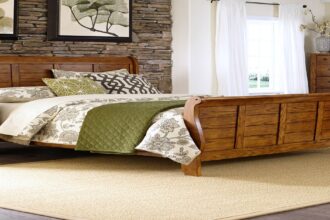When it comes to buying a new bed, you’re going to have a lot of options. There are so many different styles, sizes, materials and comfort features that there’s no way I can cover them all here. But what I can do is give you some general guidelines in order to make this process as easy as possible. Here are 10 things you should consider as you’re looking for your next bed:
Size
Bed size is important. In fact, it’s the most important thing to consider when buying a new bed! Bed sizes vary depending on where you live, so make sure you know what size mattress will fit in your room before purchasing one. In North America and Europe, beds are measured by width (length) while Asian countries measure by length (width).
Bed depth also varies from country to country: In some places like Japan and Korea it’s common for people to sleep on futons instead of mattresses–so their beds aren’t as deep as ours are here in North America or Europe where we prefer thicker mattresses with cushions made out of foam instead of traditional straw mats like those used during World War II because they’re more comfortable than sleeping directly on hardwood floors without any padding between them!
Style
When it comes to style, there is no right or wrong answer. It’s all about personal preference and what you think looks good in your room. However, you should consider the following:
- Your own style–what do you like? Are you traditional or modern? Do you prefer bold geometric prints or soft florals? Maybe both!
- Your partner’s style–if they’re not as into bedding as much as you are, their input will be helpful when deciding on a new set. If both of your tastes match up perfectly with each other (and most likely they won’t), then great! But if one person likes something very different from another person… well… then things get complicated quickly. So try not to let this happen by talking through some options before making any decisions together!
- The house’s overall vibe–is it an old Victorian house where everything needs updating? Or maybe it’s more modernistic with sleek lines everywhere else except for this one room that still feels stuck in time period X (where X could be any decade between 1890s-1980s). Whatever situation applies here: remember that buying new furniture should reflect current trends while also complementing existing decorating styles within each space around yours.”
Budget
You can get a good bed for a good price. As with most things in life, you get what you pay for. However, if you know what to look for and how to negotiate the best deal possible, then it’s possible to find an affordable bed that will last you years–even decades!
The first step is knowing how much money you want to spend on your new mattress or foundation. If this seems like an overwhelming task (and let’s face it: It probably does), start by asking yourself these questions:
How much money do I have? * When do I need this by? What does my current sleeping situation look like? Once again: Don’t worry! There are some great options out there that won’t break the bank but will still give us those comfy nights’ sleep we crave so badly at times like these.

Materials
You’ve heard the saying, “You are what you eat.” Well, it applies to your sheets as well. Depending on what material your new set is made of (cotton, polyester or silk), there are pros and cons to consider.
Here’s a breakdown:
- Cotton: This is the most popular material for sheets because it’s inexpensive and comfortable. It also lasts longer than other materials–which makes sense since cotton has been used as bedding since ancient times! The downside? If you’re prone to sweating at night or have sensitive skin (like me), then this might not be such a good choice for you because cotton tends to feel hot over time due to its absorbency properties. But if those aren’t issues for you then by all means go ahead! You won’t regret it!
- Polyester: Polyester has become increasingly popular in recent years due largely in part due its durability when compared against other fabrics such as silk which may require more frequent washing than others depending upon usage levels while still maintaining similar comfort levels throughout various stages throughout life cycle; however despite being harder wearing than many other fabrics used today there still remain some disadvantages associated with using this type material including increased stiffness when first purchased followed by softening over time due again partly due its chemical composition but mostly down
Firmness
Firmness is a personal preference. Some people like firm beds, others like soft beds. However, if you’re buying a new bed and mattress set, it’s likely that the mattress will be firmer than your current one–and that’s OK!
Firmness is related to the materials used in the bed (i.e., spring count) and type of mattress you buy (i.e., foam vs latex).
Comfort features
- Pillowtop: A pillowtop mattress is one that has extra padding on top of it. This can be foam or latex, but most commonly it’s memory foam. Pillowtops are great for people who like to feel like they’re sleeping in a cloud, because they give you that soft, squishy feeling under your body as you lay down on them.
- Memory Foam: Memory foam was first introduced in the 1970s and has since become very popular among consumers looking for comfortable beds at affordable prices (memory foam beds are often less expensive than other types). The reason for this is simple: Memory Foam conforms perfectly to your body shape so there are no pressure points or uncomfortable feelings while lying down on it! You’ll sink into its softness while still being supported by its firmness underneath; plus there’s not much motion transfer between partners when one moves around during sleeptime… which means less tossing & turning all night long!
Multiple positions
If you’re looking for a bed that can be used in multiple ways, look for one that offers different sleep settings. This will allow you to adjust the firmness of your mattress based on what position you’re sleeping in or how much support is needed.
Some beds even have adjustable bases that allow users to raise their head and feet up slightly above their bodies while lying on their backs or sides respectively–a feature that’s especially helpful for people suffering from back pain or other ailments like arthritis in their joints and muscles that may prevent them from changing positions easily without assistance from others around them (or at least some assistance from gravity).
Conclusion
We hope that this article has helped you understand all the things to consider when buying a new bed. It’s not an easy task, but we believe that by knowing what to look for in each category, you can make an informed decision and find one that suits your needs best.
Readmore : How Can I Make My Small Bedroom look luxurious?
FAQ’s
Bed size is crucial when choosing a new bed. It’s essential to ensure that the mattress fits your room dimensions. Remember that bed sizes vary across regions, with measurements differing between North America, Europe, and Asian countries.
Different materials like cotton, polyester, and silk offer distinct advantages and drawbacks. Cotton is popular for its affordability and durability, while polyester is known for its toughness. Each material has its own comfort attributes, so consider your preferences, skin sensitivity, and temperature regulation when deciding.
Look for comfort-enhancing features like pillowtops and memory foam. Pillowtop mattresses provide a soft, cloud-like sensation due to extra padding, while memory foam conforms to your body shape, offering both support and comfort. Multiple sleep settings and adjustable bases can also provide versatile sleep experiences, especially helpful for addressing specific health concerns.





